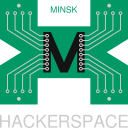An introduction to post-quantum cryptography
LVEE Winter 2016
Preface
Post-quantum cryptography is a way to preserve data security in the world of quantum computers: it is a set of algorithms and protocols resilient to cryptanalysis using quantum computing1. It has nothing to do with quantum cryptography, which is a science of using quantum mechanical properties for cryptographic tasks (e.g. secure key distribution based on quantum entanglement or data copy protection based on wave function collapse).
Quantum computing
In classical electronics each bit can be in exactly one state: 0 or 1, e.g. byte of 8 bits can encode 256 states, but can be in only one state at once. Quantum bit (known as qubit) can also encode 0 or 1 state, but can be in superposition of both states at once, so 8 qubits describe 256 states simultaneously. Qubits can be operated by quantum gates the same way as bits are operated by microelectronics gates; quantum gates are very different in nature and properties from classical gates, but can also implement a full set of logical operations. The main power of quantum computing is that single quantum gate can operate on 2^n states for n qubits available.
Quantum computers are probabilistic by the nature: 2+2 = 4 only sometimes, it may be 5 or -10 as well, but with different probabilities, so results must be verified or repeated many times to give acceptable error probability. Thus quantum computer is in no way replacement for classical computations, it is a dedicated machine that can augment classical computations, but never replace them.
Quantum algorithms
There are many quantum algorithms available, but two of them are of the most importance for crypto analysis
Shor’s algorithm
Shor’s algorithm2 allows for fast integer factorization, thus breaking prime multiplication and elliptic curve algorithms (RSA, ECDSA, ED25519 and so on). It is based on the idea of transforming factorization problem into function period finding problem (this is implemented using classical computing), finding period of a function using quantum Fourier transform. Then using a classical computations for continued fraction expansion prime can be obtained. Of course verification is needed.
As a result, search time is reduced from exponential to polynomial.
Grover’s algorithm
Grover’s algorithm3 is a “brute force” algorithm which reduces search complexity from O(N) to O(sqrt(N)), thus halving key strength, e.g. AES-256 will be reduced to AES-128.
Impact on cryptographic algorithms.
- Symmetric key cryptography
- key strength is halved, this is a danger but solvable;
- Asymmetric key cryptography
- RSA/DSA/El-Gamal – dead;
- elliptic curves cryptography – dead;
- hash-based – halve reduced;
- code-based – halve reduced;
- lattice-based – halve reduced;
- and so on…
There are plenty of asymmetric key algorithms which can’t be reduced to factorization problem. So why they are not used? The answer is: fast and effective implementation is also needed, but with modern CPUs it is not such a big problem.
Free software solutions
Encryption
Free software implementing algorithms resistible to quantum computing exists! See codecrypt4 (LGPL-3). Main features:
- functionality similar to GnuPG:
- key pair generation;
- signature;
- asymmetric encryption;
- symmetric encryption;
- import/export/recipients and so on
- many algorithms are implemented
Of course it is still new and don’t rely on it blindly, better combine with GnuPG or other schemes.
Upstream is very dynamic and responsive!
Programming
For those interested in quantum programming, you can try QCL5 (GPL-2): it is a quantum computing language with an emulator of a quantum computer!
1 Daniel J. Bernstein, Johannes Buchmann, Erik Dahmen (editors).
Post-quantum cryptography. Springer, Berlin, 2009. ISBN
978-3-540-88701-0.
https://pqcrypto.org/www.springer.com/cda/content/document/cda_downloaddocument/9783540887010-c1.pdf
2 https://en.wikipedia.org/wiki/Shor’s_algorithm
3 https://en.wikipedia.org/wiki/Grover’s_algorithm
4 http://e-x-a.org/codecrypt/
5 http://tph.tuwien.ac.at/~oemer/qcl.html
Abstract licensed under Creative Commons Attribution-ShareAlike 3.0 license
Назад



































